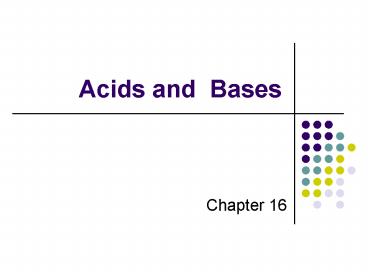Acids and Bases PowerPoint PPT Presentation
1 / 22
Title: Acids and Bases
1
Acids and Bases
- Chapter 16
2
Topics of Discussion
- Acid-Base Concepts
- Arrhenius Concept
- Bronsted-Lowry Concept
- Lewis Concept
- Acid and Base Strengths
- Relative Strength of Acids and Bases
- Molecular Structure and Acid Strength
- Self-Ionization of Water and pH
- Self-Ionization of Water
- Solutions of Strong Acid or Base
- The pH of Solution
3
Acid-Base Concepts
- Acids sour taste, turns litmus blue to red
- Bases bitter taste, turns litmus red to blue
- Arrhenius Concept
- Acids increase ?H? in aqueous solution.
- Bases increase ?OH-? in aqueous solution.
- Strong acid/base completely ionizes in aqueous
solution to produce H3O/OH- and an ion. - HClO4(aq) H2O ? H3O(aq) ClO4-(aq)
- SA HClO4, HClO3, H2SO4, HI, HBr, HCl and HNO3
- SB LiOH, NaOH, KOH, Ca(OH)2, Sr(OH)2, Ba(OH)2
- Neutralization of a strong acid by a strong base
yield the same ?H0 per mole of water formed. - H3O Cl- Na OH- ? Na Cl- H2O
4
Acid-Base Concepts-II
- Bronsted-Lowry Concept
- An acid donates a proton in a proton-transfer
reaction. - A base accepts a proton in a proton-transfer
reaction. - In any reversible acid-base reaction, both
forward and reverse reactions involve proton
transfer. - NH3(aq) H2O ? NH4(aq) OH-(aq)
- base acid acid
base - The conjugate acid-base pair consists of two
species that differ by the loss or gain of a
proton. - NH3-NH4, H2O-OH- conjugate acid-base pair.
5
Acid-Base Concepts-III
- Amphiprotic species can donate or accept proton.
- Lewis Concept
- An acid can form a covalent bond by accepting an
electron pair. - A base can form a covalent bond by donating an
electron pair. - H NH3 ? NH4
- The formation of complex ions is an acid-base
reaction according to Lewis concept. - Al3 6H2O ? ?Al(H2O)6? 3
Base
Acid
6
Example (Lewis Acid)
- Identify the Lewis acid and base. Write chemical
equation using electron dot formulas.
7
Acid Base Strengths
- The stronger acids lose their protons more
easily. - The stronger bases hold on to protons more
strongly. - HCl(aq) H2O ? H3O(aq) Cl-(aq)
- Since HCl is strong acid it completely ionizes in
water. HCl (in fact any strong acid) is stronger
than H3O. The same reaction shows H2O is
stronger base than Cl-.
8
Example (Acid-Base Strength)
- Only about 1 of acetic acid molecules ionize in
0.1 M HC2H3 O2(aq). - HC2H3 O2(aq) H2O ? H3O(aq) C2H3 O2- (aq)
- HC2H3 O2 (a weak acid) is weaker than H3O. The
strongest acids have the weakest conjugate bases.
9
Acid Base Strengths-II
- The direction for an acid-base reaction always
favors the weaker acid and weaker base. - Determine the direction of following reaction
- H2S(aq) C2H3 O2- (aq) ? HC2H3O2(aq) HS-(aq)
- The reaction goes from right to left. Reactants
are favored
10
Molecular Structure and Acid Strength
- The strength of an acid depends on how easily the
proton is removed from an H-X bond. - The more polarized the bond, the more easily the
proton is removed and the greater the acid
strength. - The larger the atom X, the weaker is the bond and
the greater the acid strength. - In going down a column, size of an atom
increases, the bond strength decreases, acid
strength increases. - HFltHClltHBrltHI
- Going across a row, the electronegativity
increases, the bond polarity increases, acid
strength increases. H2OltHF
11
Strength of Oxoacids
- Oxoacids contain in addition to H and O one other
element. H-O-Y- (acidic H is always bonded to O) - The strength of oxoacids depends on bond polarity
- For oxoacids of the same structure, differing
only in Y, the acid strength increases with EN of
Y. - HIOltHBrOltHClO, H-O-Y
- For oxoacids of (HO)m-YOn, the acid strength
increases with n, the number of O atoms bonded to
Y - HClOltHClO2ltHClO3lt HClO4, H2SO3lt H2SO4
- The acid strength of polyprotic acids and its
anions decreases with increasing negative charge. - HSO4-lt H2SO4, HPO42-lt H2PO4-lt H3PO4
12
Ionization of water
- H2O H2O ? H3O OH-
- H3OOH- KC H2O2 KW
- KW is ion product of water
- Kw 1.0x10-14 (at 25 0C)
13
The pH concept
- pH is a logarithmic system to express very small
numbers - pH -logH
- H 10-pH
- In general pX -logX
- pKW -logKW -log(1x10-14)
- -(-14) 14
14
Equilibrium constant is temperature dependent
15
pH pOH 14
16
pH calculations
- A carbonate beverage was found to have a hydrogen
ion concentration of 3.67x10-5 mol/L. What is the
pH and pOH of this beverage? - Solution
- pH -log(3.67x10-5)
- 3.44
- pOH 14 - 3.44 10.56
17
Measuring pH
- Acid-Base Indicators
18
pH meter
19
A glass electrode
20
pH of dilute solutions of strong acids and bases
- Self ionization of water
- H or OH- contribution from acid or base,
respectively. - If strong acid or base concentration is greater
than 1x10-6 M, ignore ionization of water - H total Hsolute Hwater
21
Example
- What is the pH of 0.00035 M Ba(OH)2?
- Solution
- Ba(OH)2 ? Ba2 2OH-
- OH- 2(0.00035) 0.00070 M
- pOH 3.15
- pH 10.85
22
Example
- What is the pH of 1.5x10-7 M HCl solution?
- Answer
- H HHCl Hwater
- Cl- OH-water
- 1.5x10-7 KW/H
- H2 - 1.5x10-7H -1x10-14 0
- H 2x10-7
- 6.7

